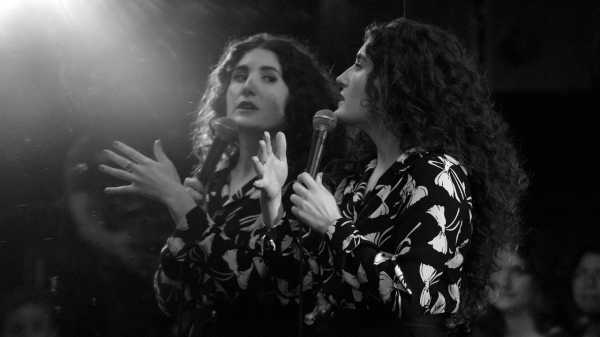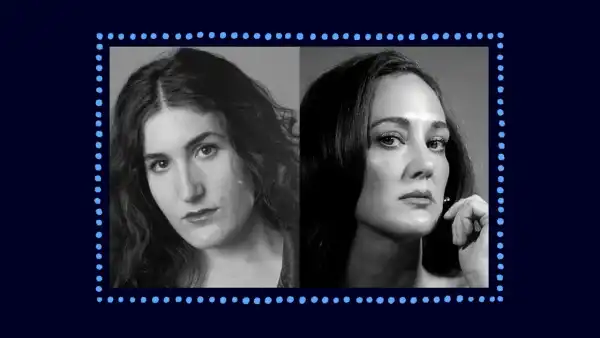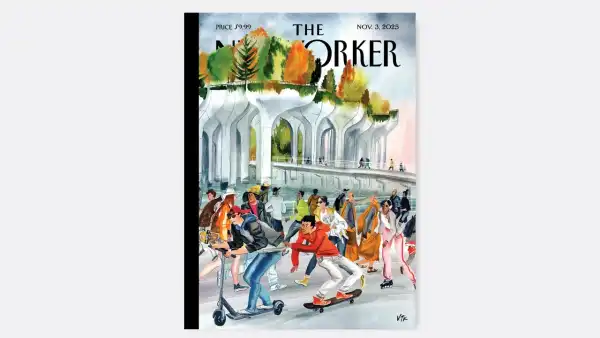
Kate Berlant’s new standup special, “Cinnamon in the Wind,” is not actually new. Directed by Bo Burnham, it was filmed in 2019 and slated to be released on FX. Instead, it languished for reasons unknown. “Show biz is a tough town,” Berlant said, on a recent episode of “Poog,” the weekly podcast that she hosts with her fellow-comedian Jacqueline Novak. “You think, Here I am, my special, here we go. Three years pass. Never got a phone call. I mean, it really is that brutal.” But, even as the networks taketh away, so, on occasion, do the networks giveth. Shorn of the commercials that were meant to accompany its broadcast and running to a cool forty-four minutes, “Cinnamon in the Wind” has just popped up on Hulu as a streaming treat. Here, at last, is Berlant.
Time can be unkind to comedy, and three years, in comedy, is a lot of time. But the delay has worked in Berlant’s favor. She’s not a topical comedian; a bit in “Cinnamon” on the two kinds of women who stand a chance of being elected President—a cooing Betty Boop sexpot or a “fridge on one wheel with a single eye”—is the closest that she gets to politics. Meanwhile, after years of being an influential figure in comedy but a niche presence outside it, Berlant, who is thirty-five, has found herself having a moment. She can be seen in juicy supporting roles as a neurotic Jewish slugger, in the television reboot of “A League of Their Own,” and as a pregnant fifties housewife, in “Don’t Worry Darling.” This summer, she and her longtime collaborator John Early released “Would It Kill You to Laugh?,” an hour-long special on Peacock that showcased their brand of absurdist humor in sketches featuring Meredith Vieira, full-body beaver suits, and an alternate reality in which people pay for restaurant meals with ladlefuls of melted caramel rather than card or cash.
Then there’s “Poog,” which Novak and Berlant started during the pandemic as a cheeky foray into the world of wellness. (The hosts’ view of the subject is expansive enough to include Gibson Martinis and steak dinners alongside serums, facial sculpting, and hydration therapy.) The podcast, which luxuriates in digression, has found a devoted following of fans who identify as Hags, me among them. Since the darkest days of lockdown, I have tuned in each Tuesday to listen to Novak and Berlant banter about whatever happens to be on their minds. Novak, whose one-woman show, “Get on Your Knees,” remains, for me, a high bar of brainy comedic bravura, is the resident theorizer, with tastes running to the scientific and the occult. Berlant is more of an id-ish sensualist. Listening to them chat is a little like snooping on a private phone call between friends—friends you wish were your friends.
They aren’t, of course, and that strange symbiotic relationship between performer and audience, the mutual craving for recognition, is Berlant’s stealth theme in “Cinnamon.” Shot in black-and-white (the sober art-house aesthetic is itself part of the joke), the special opens with Berlant backstage, warming up with balletic stretches and wrist twirls before she takes the mike to applause and cheers. “O.K., yeah, sure,” she tells the crowd, snuffing out its enthusiasm with deadpan ennui. “Don’t embarrass yourself.” It’s a power play, funny and destabilizing. Don’t all performers want to be adored? Berlant certainly does, and she handles the pressure—and the embarrassment—of that urge by turning the hard fact of her ego into comic fodder. She reminds the audience that the show is being filmed—“big night for me”—and calls, in grand diva fashion, for a spotlight, basking in its white glare before catching herself. “It’s hard to receive,” she says, in a pitch-perfect imitation of smarmy false modesty. “I think, as women, we fear our excellence so intrinsically.” (Berlant makes great sport of the kind of faux-feminist clichés that posit narcissism as a political act.) Later, she hops over to the mirrored wall at the back of the stage. “Just checking in,” Berlant tells her own reflection. “I love you.” It’s funny because it’s true.
Comedians have it harder than most other performers. They get their ratings in real time. That first burst of applause is an act of encouragement but also a kind of warning: fail to please us, and this can all go away. “The expectations: crushing, I would argue,” Berlant admits to her public. But what, exactly, does the audience expect? These days, we tend to like a drop of blood with our laughs: nothing tantalizes like the promise of a confession, the more painful the better. Berlant delights in dodging such joyless demands, preferring to satirize the notion that trauma, and the will to rise above it, is the ultimate justification for taking the stage. “One thing about me that is essential is that I do comedy primarily to process the overwhelming privilege of my childhood, adolescence, and now adulthood,” she says. She grew up “almost collapsing under the weight of resources,” a condition that she illustrates by slumping dramatically from the neck and shoulders, the artist crushed under the bourgeois burden of so much good luck.
Berlant is a born entertainer, and her extraordinary physicality is one distinguishing delight of her comedy. The way that she uses her body, madly shuffle-dancing across the stage or popping her eyes cartoonishly wide, is pure vaudeville. She can crack a joke with her knees. She has one of the great contemporary faces in comedy: a long, elegant nose and jutting chin; high, round cheekbones framed by a shock of dark curls. It’s a mobile, Etch A Sketch sort of face. No sooner has Berlant fixed it in one fantastic contortion—eyes crossed, lashes fluttering, lipsticked mouth pursed like the pinched end of a helium balloon—than she shakes loose and resets. There’s a bit of Jim Carrey in that itch to constantly morph and contort, and a whole lot of Lucille Ball. Watch, in a bit about museumgoing, as she turns herself into a pan-flute-playing court jester from a Renaissance painting, just because she can.
“Cinnamon in the Wind,” a phrase that Berlant uses as a metaphor for the ecstatic brevity of life, usefully doubles as a description of her standup style. Berlant is not a storyteller. The show doesn’t so much build as jolt forward in a series of rapid-fire riffs and bits: an idea is caught, a motif taken up, then dropped as Berlant moves on. A friend of mine likened the experience of watching the special to scrolling through a social-media feed: next, next, next. This makes for huge fun in the moment. It also means that Berlant can shrug off anything that doesn’t work, and even things that do—a dodger’s artful way of refusing to commit.
In a recent profile of Berlant in the Times, Jason Zinoman reported that, after years of being cited admiringly by fellow-comedians whose fame had come to surpass hers, Berlant began to feel “trapped by her act.” After a break from performing during the pandemic, she was challenged by Burnham to stop futzing around and “make something” with a proper structure and proper stakes. The result is “Kate,” a one-woman show, also directed by Burnham, at Connelly Theatre, in the East Village, in which Berlant plays multiple characters, as well as multiple versions of herself: the starry-eyed ingenue, the tyrannical diva, and, truest to life, the super-talented entertainer who has yet to find her breakout role.
“Kate” picks up where “Cinnamon” left off, taking the premise of autobiographical confession and twisting it like taffy. The tricks begin in the lobby, where audience members are greeted by a mock art installation devoted to the greatness of Kate. There is the requisite selfie wall, where people are encouraged to pose alongside black-and-white photographs of Berlant, looking very nineties Calvin Klein in her signature onstage getup of black jeans, black tank top, and black boots. The outfit itself is on display in a plexiglass box; Berlant’s Moleskine notebook is in another. There’s a Warholian riff here on celebrity—or the aspiration to celebrity—as a performance in its own right. Come early enough and you may catch a glimpse of Berlant, slouched on a bench, holding a sign that says “Ignore Me.”
In the theatre itself, Berlant’s arrival is preceded by more meta antics. Audience members are first encouraged, by a disembodied, Oz-ian voice, to introduce themselves to a neighbor (mine was, no surprise, a fellow Hag), then treated to a comically grandiose slide show, which features a scroll through Berlant’s IMDb page and situates her in the grand Method tradition of Stanislavski, Adler, Strasberg, and Meisner. By the time that Berlant comes out, dressed like a newsie in peaked cap and overalls and claiming, in a gummy, Bronx-ish accent, to be employed as a stage-sweeper, expectations are so high that it’s impossible to know what to expect.
What transpires, once Berlant has shed her maintenance-man persona, is something less revelatory than what the hoopla might suggest. On the bare stage, equipped with a camera and tripod and a screen that stands in for a set (locations are conveyed by projected words like “Porch” or “Club”), Berlant spins a tale of a star struggling to be born. Since her childhood in the small seaside town of Santa Monica (ever heard of it?), Kate has dreamed of being a Hollywood actress. This ambition was encouraged by her father and disparaged by her mother, who warns that Kate’s “big, crass style of indication has no place on camera.” Convinced that she can never make it onscreen, she moves to New York to pursue a career onstage, finding fulfillment in the downtown theatre scene until a fateful encounter reignites her cinematic dreams. Not since the heyday of Jenna Maroney has the camera been treated as such a comedic love object; Kate is drawn to it like Gollum to the ring. As she gazes into its lens, her image (again in black-and-white) is projected onto the screen, a digital Narcissus’ pool. A joke on the “nuances” of film acting, briefly touched on in “Cinnamon,” is developed at length; there’s a subplot of sorts involving a feud with a backstage-tech guy and the promise of a visit from a big executive. Meanwhile, we get a sendup of the trappings of trauma drama. Kate was marked by a childhood tragedy (her father left the family), she promises to divulge a long-buried secret, and she explores her fatal flaw as a film actress—her inability to cry on demand.
There’s a lot to enjoy here, including a fantastically unhinged improv sequence at the show’s peak. But, as the minutes tick by—more than eighty of them, by my count—the appeal of the pastiche wears thin. One puzzle of Berlant as a performer is that when she acts in scripted roles she always seems so irrepressibly Berlantish, but when she’s onstage, performing as herself, she’s intent on reminding us that her persona is mere guise. Speaking with Zinoman, Berlant described her work in “Kate” as the “semiotics of theater without the content.” That’s a fancy way of saying that she’s not sure she has much to say. Does she need to? Maybe not, but the show’s strongest moment comes when Berlant breaks through—or pretends to break through—the Kate carapace, accosting the audience for extending her good will. Why, she demands, are we here, in this shitty little theatre, laughing like chumps on command? The Connelly seats about a hundred and fifty; if that many people liked one of her Instagram posts, Kate fumes, she would kill herself.
This face slap of a rant, genuinely bracing, even a little insulting, gets closest to what I think Berlant really does want to talk about: her own uncertainty about what she’s doing, the rawness of wanting more acclaim than she has, the not entirely satisfying collaboration with an audience that worships her but can’t give her everything she wants. Later, she apologizes—she needs us, she loves us! Judging by the many rapturous responses that “Kate” has received, the feeling is mutual: Kate’s fans can seem as eager for her approval as she is for theirs. One wonders, though, what would happen if Berlant tried to free herself from such meta power plays. “My work is, of course, endurance based—it’s kind of about you enduring me,” Berlant jokes, in “Cinnamon.” She has our attention. What will she do with it next? ♦
Sourse: newyorker.com






